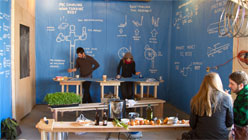Only Birds Sing the Music of Heaven in this World, a multimedia group exhibition curated by artist Harrell Fletcher, plumbs the overlap between contemporary art and craft, socially engaged practices, and agriculture. The title is borrowed from early 19th century Japanese poet Issa, a regular influence on Fletcher’s work. It reflects, in his words, “the impossibility of trying to make ‘art’ when ‘nature’ does a much better job of making art.” Anyone who has seen fresh produce at the farmer’s market might concur. Beyond imagery, the gnarled politics of food production are increasingly the territory of artists who challenge social issues with creative solutions, as only artists can.
Last year San Francisco-based collective Futurefarmers, with Amy Franceschini, created Soil Kitchen 2011, a temporary, windmill-powered architectural intervention and multi-use space where North Philadelphia neighbors traded soil samples in exchange for free soup. Over a six day period, Soil Kitchen tested 350 samples and served 1800 bowls of soup made from local vegetables grown on formerly abandoned post-industrial land redeveloped for food production, known as a “Brownfield.” Coinciding with an Environmental Protection Agency conference on Brownfields, the project facilitated workshops in wind turbine energy, urban agriculture, soil remediation, composting and cooking lessons — essentially empowering the local community with the necessary tools to reclaim public spaces for the greater good. Soil Kitchen is presented here as a scale model, accompanied by two spare drawings, and a short not-to-be-missed video. Adjacent to this are work samples from Natasha Wheat’s Project Grow, an ongoing collaboration between fifty artists and farmers at the Port City Developmental Center, a vocational day program for adults with developmental disabilities in Portland, Oregon. In 2008 Wheat proposed transitioning the program from income-dependency on “piece-rate” factory labor to the sale of arts and crafts through the farm’s newly launched CSA (community supported agriculture) program. Today the site houses a woodworking program, along with textile and fiber arts, an art gallery, art studios and the North Portland farm; most critically, Wheat’s experimental proposal developed into a model of sustainability.
Projects such as these have roots in earlier social experiments such as Bonnie Ora Sherk’s Crossroads Community (the farm) 1974-1980, a life-scale environmental artwork, also shown here. The farm created a community hub from disparate San Francisco parcels of land ringed by major freeway interchanges and was one of the first inner-city Brownfield projects undertaken by the Trust for Public Land. It included live/work spaces for artists, a hands-on educational farm, a pre-school, a library, a gallery space and a performance space for theatre and punk rock. Experimental performance artist Mark Pauline of Survival Research Laboratories was an early resident.
Socially engaged practices, by necessity, are often represented as documentation and video — finding a balance between so much media and actual art objects is a common challenge. A series of photographic reproductions depicting the 1965 Delano Grape Strike lends a mild material presence to the exhibition, along with reproductions of other ephemera from the Cesar Chavez Foundation. But how to best represent a 340 mile protest march? The potent politics embedded in these prints is undercut by their static nature, with so much video present elsewhere. Further the historic issue of racial disparity in agriculture feels underserved, though the Delano Grape Strike is fore grounded in the publication — a lovely newspaper designed by John Borruso.
Discussion around socially engaged projects often boils down to a semantic debate around the nature of art, with some disregarding actions in favor of the art object. Perhaps in anticipation of this old argument, farm scene prints by Wayne Thiebaud and Bernard Zakheim’s painting Tractored Out 1941 unduly command space where more dynamic contemporary projects could have been considered, such as Asiya Wadud’s Forage Oakland or the work of Los Angeles-based collective Fallen Fruit. Each champions access to fresh produce and challenges traditional notions of food production.


